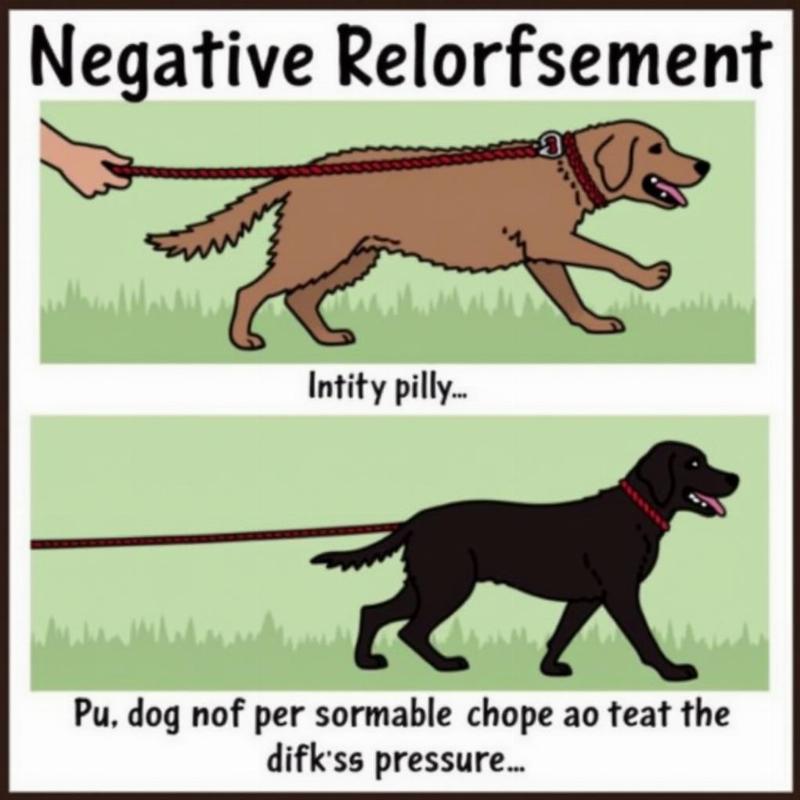Negative reinforcement is a common training term that often gets confused with punishment. Understanding the difference is crucial for effective dog training in the US. If you’re asking yourself, “Does negative reinforcement work on dogs?”, you’re in the right place. This article will clarify what negative reinforcement is, how it differs from punishment, and how to use it ethically and effectively with your canine companion.
Understanding Negative Reinforcement in Dog Training
Negative reinforcement involves removing something unpleasant to increase the likelihood of a desired behavior. It’s not about punishing your dog. For example, if your dog pulls on the leash, a tight leash is uncomfortable. When they loosen the leash, the pressure is released – that’s negative reinforcement. The dog learns to walk loosely to avoid the unpleasant pressure. Another example is using a gentle pressure on a dog’s back to encourage them to sit. When they sit, the pressure is released, reinforcing the sitting behavior.
 Negative Reinforcement Dog Training Example
Negative Reinforcement Dog Training Example
Negative Reinforcement vs. Punishment: A Critical Distinction
Many pet owners in the US confuse negative reinforcement with punishment. Punishment focuses on decreasing an undesired behavior by adding something unpleasant (positive punishment, like a scolding) or removing something pleasant (negative punishment, like taking away a toy). Negative reinforcement, however, increases a desired behavior by removing something unpleasant. Punishment can create fear and anxiety, damaging your bond with your dog. Negative reinforcement, when used correctly, can be a humane and effective training tool.
How to Use Negative Reinforcement Effectively
The key to using negative reinforcement effectively is to be consistent and clear. The unpleasant stimulus should be mild and only present when the dog is exhibiting the undesired behavior. As soon as the dog performs the desired behavior, the unpleasant stimulus should be removed immediately. Timing is crucial.
Practical Examples of Negative Reinforcement in Dog Training
- Leash Pressure: As mentioned earlier, releasing leash pressure when a dog walks nicely is a common and effective example.
- Head Halter: The slight pressure of a head halter when a dog pulls can be released when they stop pulling, teaching them to walk politely.
- Car Sickness: If your dog gets carsick easily, try short car rides to a fun destination, like a park. The unpleasant feeling of car sickness is removed when the car stops at the park, associating car rides with something positive.
Common Mistakes to Avoid with Negative Reinforcement
- Applying the unpleasant stimulus too harshly: This can lead to fear and anxiety. The pressure, sound, or sensation should be just enough to motivate the dog.
- Inconsistent application: If you don’t remove the unpleasant stimulus immediately when the dog performs the desired behavior, they won’t make the connection.
- Confusing it with punishment: Scolding or hitting your dog is not negative reinforcement.
Is Negative Reinforcement Right for Your Dog?
Negative reinforcement, when used correctly, can be a powerful training tool, but it’s not always the best approach for every dog or every situation. Some dogs are more sensitive than others and may respond better to positive reinforcement methods.
“Negative reinforcement can be highly effective, but it’s crucial to understand the nuances and avoid common mistakes,” says Dr. Emily Carter, DVM, a certified veterinary behaviorist in New York. “Always prioritize your dog’s well-being and consult with a qualified trainer if you’re unsure about the best training approach.”
“Remember, consistency and patience are key to any successful training program,” adds Sarah Miller, a certified professional dog trainer based in Los Angeles. “Building a positive relationship with your dog should always be the foundation of your training efforts.”
Conclusion
Does negative reinforcement work on dogs? Yes, when implemented correctly. It’s a valuable tool for teaching desired behaviors by removing unpleasant stimuli. However, it’s essential to understand the clear distinction between negative reinforcement and punishment. By focusing on consistency, timing, and using humane methods, you can effectively use negative reinforcement to build a stronger bond and better communication with your furry friend. Remember to prioritize your dog’s well-being and seek professional guidance if needed.
FAQ
- What’s the difference between negative reinforcement and positive punishment? Negative reinforcement removes something unpleasant to increase a behavior. Positive punishment adds something unpleasant to decrease a behavior.
- Can negative reinforcement be harmful to my dog? If used incorrectly, it can cause fear and anxiety. Always use mild stimuli and be consistent.
- Is negative reinforcement the best way to train my dog? Not always. Some dogs respond better to positive reinforcement methods. Consult a trainer for personalized advice.
- What are some examples of negative pressure? Leash pressure, head halters, and even a gentle nudge can be considered negative pressure when used in training.
- What should I do if I’m not sure how to use negative reinforcement? Consult a certified professional dog trainer or a veterinary behaviorist.
- Is negative reinforcement the same as ignoring bad behavior? No. Ignoring bad behavior is a form of extinction, which is different from negative reinforcement.
- Can I use negative reinforcement with puppies? Yes, but with extra caution. Puppies are more sensitive, so use very gentle pressure and focus on positive reinforcement methods as well.
Beautdogs.us: Your Trusted Resource for Dog Care
Beautdogs.us is your premier online destination for all things dog-related in the US. We offer expert advice on dog breeds, care, training, and products, catering to both new and experienced dog owners. Our mission is to empower you with the knowledge and resources you need to provide the best possible care for your canine companion. From breed-specific information to training tips and product reviews, we are your trusted source for comprehensive and engaging dog care content. Contact us today to learn more! Email: [email protected], Phone: +1 501-555-7529.